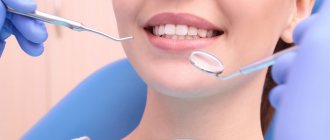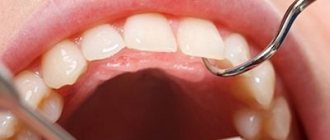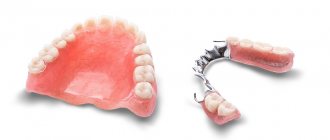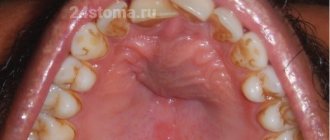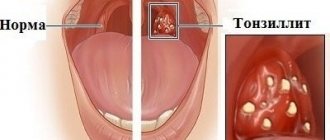Periodontitis is an inflammatory periodontal disease that, without appropriate treatment, leads to destruction of the periodontal junction and tooth loss. It begins with inflammation of the gums, which occurs as chronic gingivitis. Subsequently, the pathological process affects deeper tissues, leading to the destruction of the periodontium, dental alveoli (socket), and the adjacent jawbone.
The tooth and periodontium are a single functionally and morphologically related system. The defeat of its individual elements disrupts the functionality of the dental unit, leads to disruption of the periodontal attachment, the formation of deep periodontal pockets, the formation of abscesses, fistulas on the gums, loosening, and tooth loss.
Symptoms
- Inflammation of the gums;
- hyperemia (redness) of the mucous membrane, swelling, reaction to temperature stimuli;
- sore gums;
- discomfort, bleeding gums when chewing, oral hygiene;
- detachment of the gum from the tooth wall;
- formation of periodontal pockets;
- abundant plaque and tartar around the tooth;
- pus from the gums;
- loosening of the gum edge;
- exposure of tooth roots;
- tooth mobility;
- inflammation of the submandibular lymph nodes
Symptoms of periodontitis vary depending on the extent of the inflammatory process. The more severe the stage of the disease, the more pronounced the symptoms. The disease does not occur suddenly; the early stage of periodontitis is catarrhal gingivitis - inflammation of the gums, not accompanied by a violation of the integrity of the mucous membrane.
Treatment and prevention of periodontitis at home
After successful treatment of periodontitis, it is necessary to pay increased attention to oral hygiene. To do this you should:
- Visit your dentist regularly to remove plaque and tartar;
- eliminate caries and fill dental canals at the slightest manifestation of pathological processes;
- use hygiene products designed to prevent gum disease;
- After each meal, use dental floss and mouthwash with an antiseptic;
- follow other rules for the prevention of periodontitis.
Classification
Periodontitis is classified according to location, nature of the course, and severity.
According to the nature of the flow
There are acute and chronic forms. In the first situation, the signs of periodontitis are pronounced, the gums are loose, bleed, and hurt. If the patient does not consult a doctor or ineffective treatment is prescribed, the disease takes a chronic course. In the chronic form, the symptoms are smoothed out, there are no acute signs of inflammation, but the consequences are more severe. Chronic pathology is characterized by periodic exacerbations, when the symptoms become pronounced.
By localization
According to the distribution of the pathological process, periodontitis is divided into:
- Localized
(focal) - occurs in a small area, in the area of 1 or several teeth. - Generalized
periodontitis is inflammation of all or most teeth in a row.
The symptoms of localized and generalized forms of the disease are no different, the only difference is in the number of teeth around which the pathological process has spread.
Degrees of periodontitis
- Mild
– fiber disintegration of the compact plate, reduction of the interalveolar septum to 1/3 of the length of the tooth root, signs of osteoporosis, slight tooth mobility, periodontal pockets of 2.5-3.5 mm. - Medium
– the depth of periodontal pockets increases to 5 mm, moderate tooth mobility is observed (grades I-II), bone atrophy around the teeth reaches 1/2 of the roots. Exposure of the necks and roots of the teeth or inflammatory growth of the gums occurs, abscesses (abscesses in the gums) can form. The teeth begin to “diverge” under chewing pressure, and the gingival margin becomes deformed. This is especially noticeable in the area of the front incisors. The gums bleed when chewing or brushing teeth, the necks of the teeth are exposed, and react painfully to temperature stimuli. - Severe
– symptoms increase, exacerbations of chronic periodontitis in adults are accompanied by the formation of abscesses, severe swelling of the gums, and pain. The depth of periodontal pockets reaches 6 mm, right up to the root apex. The interdental spaces increase, there is strong tooth mobility (II-III degrees), bone resorption, up to complete resorption of the alveolar septum.
Depending on the individual characteristics of the body, the disease progresses differently. Aggressive forms of periodontitis are characterized by rapid, almost rapid destruction of periodontal tissue, loosening of teeth, and their painless loss. In another part of patients, the disease progresses slowly, with occasional exacerbations, and long remission.
The most severe form is necrotizing periodontitis.
, in which the gum tissue stops receiving nutrition, blood circulation in them stops, and necrosis of the periodontium, periodontal ligaments, and alveolar bone occurs. This form of the disease occurs in patients with severe immunodeficiency conditions (AIDS, DiGeorge syndrome, SCID, etc.).
Is it possible to eliminate periodontitis with a laser?
Laser treatment of periodontitis is one of the most effective and minimally invasive ways to combat the disease, which is one of the stages of complex treatment. The laser has cleansing and antibacterial properties. During the procedure, each periodontal pocket is treated for a certain time, sufficient for the laser light beam to destroy pathogenic bacteria. The procedure is bloodless and virtually painless. However, a good effect can only be obtained with an integrated approach to the treatment of periodontitis.
Causes of periodontitis
A decisive role in the development of the disease is played by pathogenic microorganisms in dental plaque, which contribute to gum inflammation. The accumulating bacterial plaque hardens. Tartar builds up and penetrates deep into the gums, causing the mucous membrane to begin to peel off from the tooth, creating a free space that is gradually filled with pathogenic bacteria. Gingivitis develops, which without proper treatment quickly transforms into acute periodontitis.
Factors that provoke the development of periodontitis also include:
- regular injury to the gums due to incorrectly installed dentures and orthodontic systems;
- incorrect occlusion;
- accumulation of food particles and plaque under prosthetic and orthodontic structures;
- smoking and alcohol abuse;
- decreased immunity;
- physical trauma to teeth (impact);
- bruxism.
The development of chronic periodontitis can be influenced by problems with the gastrointestinal tract, endocrine disorders, blood diseases, vitamin deficiency, metabolic disorders, insufficient chewing load (the predominance of soft foods in the diet), autoimmune pathologies, and allergies to certain medications.
Prevention and treatment of periodontitis at home
The most effective method of treating almost any disease, including periodontitis, is its prevention. There are simple prevention methods that can be used at home. Their use will prevent the occurrence of periodontitis symptoms and avoid the need for drug and surgical treatment.
The main thing that needs to be done to prevent any pathologies of the oral cavity is to strictly follow the principles of dental hygiene:
- brush your teeth twice a day with therapeutic and prophylactic toothpaste using a medium-hard brush;
- After a meal, remove leftover food using dental floss.
- a rinse with an antibacterial effect, for example, Asepta based on lemon balm, calendula or St. John's wort extract, has a soothing effect on the gums;
- it is necessary to regularly consume solid and plant foods, ensuring sufficient chewing load on the teeth;
- one of the reasons for the development of periodontitis is a lack of vitamins A, C and B vitamins in the diet. To prevent the disease, it is recommended to take a vitamin complex containing a sufficient amount of these vitamins;
- You should visit your dentist twice a year for preventive teeth cleaning. Timely removal of plaque and tartar will help avoid gum inflammation and further development of pathology.
Diagnostics
- Taking anamnesis;
- dental examination with measurement of the depth of periodontal pockets (periodontogram);
- orthopantomogram (OPTG), CT;
- rheoparodontography (assess the tone of blood vessels);
- Schiller-Pisarev test;
- microbiological studies (PCR);
- blood tests (general, sugar).
Differential diagnosis of periodontitis is carried out with gingivitis, eosinophilic granuloma of the jaw, periodontal changes in Lefebvre-Papillon syndrome. What examination methods will be required depends on the form and severity of the disease.
Treatment with antibiotics, dental ointments and gels
Drug therapy is possible after professional teeth cleaning as prescribed by a doctor. Antibiotics should be taken in recommended doses in the absence of inflammatory processes in the oral cavity.
In some cases, during treatment, injections are prescribed simultaneously with the drugs Traumeel and Lincomycin.
To relieve symptoms, the dentist prescribes gels and ointments:
- "Metrogil Denta" is an anti-inflammatory, analgesic agent;
- "Cholisal" - a gel to combat gum inflammation;
- "Kamistad" - for the prevention of gingivitis, relieving swelling, eliminating pain;
- “Gengigel” is a gel that increases blood circulation and promotes the regeneration of soft tissues;
- "Stomatofit" - to relieve severe pain;
- "Asepta" - to stimulate tissue regeneration processes;
- "Solcoseryl" is an antiseptic with a healing effect.
Treatment methods
Treatment includes a complex of local and general measures, prescribed individually, based on the results of the examination, according to the severity of the disease, the characteristics of its course, and general health. Effective comprehensive treatment of periodontitis is aimed at eliminating periodontal pockets, strengthening teeth and gums, and preventing the destruction of soft and hard tissues.
Hygienic cleaning
Regardless of the stage of the disease, the first stage of treatment is the removal of all dental plaque. For this purpose, special ultrasonic equipment is used, which allows you to carefully remove plaque and stone even in the most inaccessible places. After curettage (scraping) or ultrasonic cleaning performed using manual instruments, the gums are treated with an antiseptic, and medicinal dressings with an anti-inflammatory and antimicrobial agent are applied.
Drug therapy
For mild cases of the disease, local medications for periodontitis are prescribed (gels, ointments, rinses) that have anti-inflammatory, antimicrobial, and healing effects. In difficult cases, systemic antibiotic therapy, hormonal and antihistamine medications, and vitamin and mineral complexes are prescribed. Conservative treatment is effective at an early stage of the disease.
Preparations for the treatment of gum periodontitis have anti-inflammatory, analgesic, and antiseptic effects. The therapeutic effect is provided by using the drug as rinsing solutions, applications to the gums, tablets for oral administration, injections into the gums (vitamins, FiBS, aloe preparations, etc.). Course of treatment – from 2 to 4 weeks
at intervals of several days.
Physiotherapy
For the speedy elimination of the infectious focus and active tissue regeneration, additional physiotherapeutic procedures are prescribed - ultraphonophoresis, darsonvalization, ozone therapy, electrophoresis, gum massage, laser therapy. Localized periodontitis can be completely cured at an early stage without resorting to drastic measures. That’s why it’s so important to see a dentist at the first warning signs of illness.
Orthopedic treatment
During the treatment, orthopedic structures are corrected, parts of the fillings are removed from the interdental spaces, and crowns that have sunk deeply under the gum or are installed incorrectly are replaced. Splinting for periodontitis is indicated for degree II tooth mobility. Temporary splinting is carried out before curettage or immediately after it, permanent splinting is carried out a month after treatment.
Surgical methods
In severe cases of periodontitis, with deep periodontal pockets and defects of the gingival margin, in addition to conservative treatment, surgical treatment is required. Radical intervention involves cleaning the periodontal pockets with and without dissection of the gums, gingivectomy is an operation to remove inflamed, overgrown areas of the gums. The intervention involves reducing the volume of gum pockets and forming an aesthetic gingival margin. After the procedure, the natural process of tissue regeneration begins. When the alveolar septa are completely reabsorbed, excessively mobile, non-viable teeth are removed.
In case of significant destruction of the jawbone, when it cannot firmly hold the tooth in place, osteoplastic surgery is performed - directed bone regeneration. To do this, the area between the tooth and the bone is filled with a biocompatible osteoplastic material, which serves as a platform for the formation of new osteoblasts and restoration of bone volume.
Modern methods of treating periodontitis, such as laser and vector therapy, show impressive results. In just one procedure, gum pockets are reduced, swelling, pain, and bleeding disappear. Non-contact methods have a biostimulating effect and significantly accelerate tissue healing. Regardless of the severity of periodontitis, the correct occlusion is determined for all patients, and selective grinding of the teeth is carried out according to indications.
Professional hygiene for effective treatment of periodontitis
In the vast majority of cases, the development of this disease is associated with insufficient oral hygiene. The periodontal tissues become inflamed due to extensive dental plaque, so the first thing to do to treat periodontitis is a professional cleaning.
This procedure includes the following steps:
- removal of dental plaque
- polishing the tooth surface
- treating the tooth with protective varnish.
Modern cleaning methods are gentle on the enamel and cause minimal discomfort. Also, at the stage of removing tartar and plaque, preparations should begin for the treatment of caries and the removal of hopelessly affected teeth.
Is it possible to treat at home?
Decoctions of medicinal herbs (tricolor violet, calendula, lingonberry leaf, calamus, oak bark) will help relieve symptoms of acute inflammation. But no amount of rinsing will get rid of supragingival, and especially subgingival dental plaque. Only professional hygienic cleaning at the dentist's office can handle this. Folk remedies in the form of formulations of hydrogen peroxide, soda and lemon will only aggravate the situation. But maintaining the condition of your gums after treatment at home is not only possible, but also necessary. The dentist will give you all the necessary recommendations on how to treat periodontitis at home.
Orthodontics comes to the fore
Today, a huge mistake is happening both in the search for the causes of periodontal disease and in making a diagnosis, as well as in the method of effective treatment. Instead of putting the tooth into occlusion, removing it from a traumatic bite, patients are offered all these manipulations that I have previously voiced, which are not at all aimed at getting rid of these complaints, but only at the fact that patients are wasting time, the processes are getting worse.
In the treatment of the so-called periodontal disease is a big problem in the loss of time for inadequate treatment, and the loss of time for the patient is a complication of the pathology of dental occlusion, and the transition of the stage of the disease to a more advanced form.
If a patient, for example, three years ago had a loss of bone tissue of two millimeters, then due to the “treatment of periodontal disease” he has already lost five millimeters, that is, we have lost time.
And if he came to the orthodontist with a loss of bone tissue of two millimeters, then it would be easier to stop the loss of gums, it would be easier to eliminate the development of gum pathology after orthodontic treatment, when the teeth become aligned with the dentition.
We can already talk about the fact that we close all exposed necks of gum recession, thereby treating the neck of the tooth. But when patients waste time on treatments that are inadequate for the disease, sometimes closing the recession is no longer possible. Because there are also strict indications and contraindications for the treatment of gum recession.
How to restore teeth with severe periodontitis
In severe cases of the disease, the risk of losing a tooth or an entire row of teeth is very high. Tooth extraction for periodontitis is indicated in cases of excessive mobility, when the unit is barely held in the bone and moves in all directions around its axis. If it is impossible to save the tooth, orthopedic treatment is carried out - prosthetics supported by natural teeth or implants.
For single defects or restoration of a tooth segment, two-stage implantation with delayed loading is used. Implants are implanted after a course of gum treatment and restoration of bone volume. Bone parameters are restored through osteoplastic surgery. After new bone tissue is formed (after 6 months), implants are implanted, the prosthetic system is fixed after they have fused with the jaw bone ( after 3-6 months
). Treatment may take about a year.
In case of complete edentia, one-stage implantation methods with immediate loading demonstrate high efficiency. The ability to install implants in deep bone layers that are not subject to inflammation allows you to avoid osteoplasty and sinus lifting. Treatment will take no more than a week.
What consequences can untreated periodontitis lead to?
Loss of teeth
The advanced stage of the disease destroys the soft and hard tissues around the teeth, which leads to their loss.
Deterioration of conditions for implantation
As mentioned earlier, with severe periodontitis, the volume of the jaw bone is significantly reduced, which makes it difficult to install implants, requiring preliminary bone growth, and in extremely severe cases makes implantation impossible.
The occurrence of other diseases
Periodontitis contributes to diseases of the gastrointestinal tract, diseases of the lungs, heart and even the formation of blood clots.
Differences between periodontitis and periodontal disease
| Periodontal disease | Periodontitis | |
| Pathogenesis | Systemic dystrophic periodontal disease | Infectious and inflammatory periodontal disease |
| Character of the course | Develops slowly, asymptomatically | Develops quickly, often recurs, symptoms clearly manifest themselves in the acute period |
| Causes | Mainly systemic pathologies of the body, hereditary predisposition | Poor hygiene, excessive bacterial plaque, tartar, malocclusion, jaw injuries |
| Prevalence | A segment of teeth or the entire dentition is affected | Inflammation is localized in the area of one, several teeth or affects the entire jaw |
| Inflammation and bleeding gums | Absent | Main features |
| Tooth mobility | Occurs when gum recession extends more than 1/2 the length of the tooth root | It is observed in the acute period of the disease, against the background of looseness, swelling, and bleeding of the gums. Disappears after treatment |
| Forecast | Requires constant, maintenance therapy. In moderate and severe forms, the process only needs to be stabilized. The overall prognosis is poor (tooth loss) | With timely treatment, complete recovery |
Acute and chronic periodontitis: symptoms and treatment
As mentioned, the treatment plan will depend on the severity of the inflammation and how widely it has spread. Periodontitis affecting a few teeth is localized; periodontitis affecting most (or all) teeth is generalized.
Acute periodontitis, which has pronounced symptoms, occurs less frequently than chronic periodontitis and usually affects one or two teeth. It is often caused by trauma to the tooth or periodontal tissue, or improper installation of a crown or filling. This type of disease often occurs aggressively, causing rapid destruction of bone and muscle tissue.
If the pathology is chronic, then phases of exacerbation are replaced by phases of remission. At the same time, chronic periodontitis slowly and steadily progresses from the initial stage to the severe one. This form of pathology can be caused by both local factors (for example, trauma to the oral cavity) and general ones.
Is it possible to cure periodontal disease forever?
Treatment of the disease is carried out comprehensively with the involvement of specialists in the field of dentistry, immunology, endocrinology, gastroenterology, and therapy. The essence of treatment is to eliminate symptoms, strengthen teeth and prevent relapses. Additionally, restoration of lost tissue is carried out.
It is problematic to cure periodontal disease in the last stage, but contacting competent doctors will help get rid of unpleasant sensations and stop the further development of the disease, preserving your teeth.
Splinting
A treatment method used to strengthen loose teeth. Splinting involves combining individual teeth into a single orthopedic structure in the form of a block to reduce their mobility.
Prosthetics
Prosthetics for periodontal disease are carried out in combination with other treatment methods; it is possible to install several types of dentures, depending on the condition of the gums. Removable prosthetics helps reduce the load on areas affected by periodontal disease: installing clasp, nylon dentures that do not rub the mucous membranes and have a fastening system that does not damage the supporting teeth.
In some cases, permanent bridge structures are used to strengthen a number of teeth located one behind the other.
Prosthetics does not eliminate the cause of the disease. Without an integrated approach, tissue reduction will continue, and after 3-5 years the patient will need replacement prostheses.
